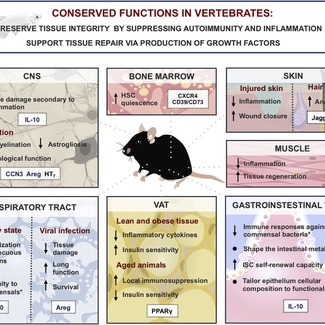Roles of Regulatory T Cells in Tissue Pathophysiology and Metabolism
Abstract
Cellular differentiation and tissue organization are defining features of metazoans. Unlike unicellular entities, multicellular organisms carry out physiologic functions through the concerted action of specialized cells assembled in discrete units; therefore, safeguarding the function of these units or tissues is of paramount importance to organismal homeostasis. Besides stromal and parenchymal cells, tissues harbor a significant population of recirculating and resident immune cells that include phagocytes, specialized antigen-presenting cells (APCs), and innate and adaptive lymphocytes. Regulatory T (Treg) cells, a specialized immunosuppressive lineage of the latter, have been shown to exert systemic effects on metabolism and partake in tissue repair, suggesting a dual role for adaptive lymphocytes in serving and protecting tissues. This review highlights the main mechanisms by which Treg cells support tissue function.

Be the first to leave a comment!